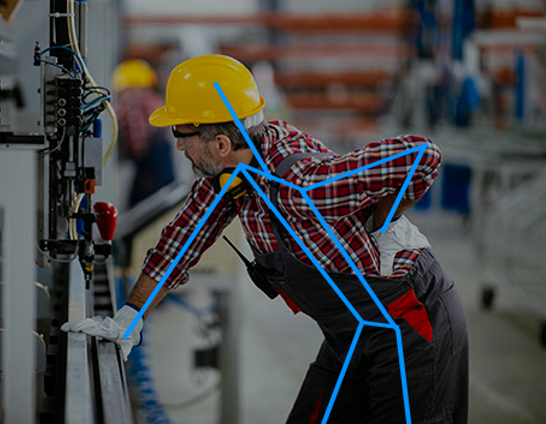Ergonomic risk analysis is a powerful computer vision application where deep learning algorithms are used to analyze the video of cameras for real-time posture assessments. Read how your organization can use computer vision for automated posture assessment with AI-based posture-tracking technology.
What is AI-based Ergonomic Risk Analysis?
Ergonomic risk factors are workplace situations that cause wear and tear on the body and can cause injury. Common ergonomic hazards include repetition, awkward posture, high force, forceful motion, stationary position, direct pressure, vibration, and work stress.
Vision-based ergonomic risk analysis uses cameras to detect the human posture of workers. Deep learning methods detect the body parts and joints (semantic keypoint tracking) to analyze human movement in real-time or periodic snapshots. A camera-based ergonomic risk assessment can detect the occurrence of specific poses as well as the frequency of specific events.
Ergonomics Detection Features
Depending on the ergonomics use case, there are different deep learning methods to perform automated ergonomic risk assessments using conventional video cameras. Modern, Edge AI methods allow privacy-preserving image analysis with on-device processing: no video is sent to the cloud or stored locally, no human operators are needed.
- Deep learning models based on posture detection: Detect specifically trained postures such as sitting, standing, walking, and laying down with frequency and duration per event.
- Keypoint-based analysis to track the body limbs and joints. The real-time tracking of key points involves heavy algorithms that require capable AI hardware.
- Track changes in human postures to identify specific activities and workflows.
- Measure, quantify, and monitor specific ergonomic metrics and set up rule-based reporting.
Value of Ergonomics Recognition Systems
The recognition and monitoring of human postures using camera systems provide a highly efficient method for ergonomic risk assessments.
The detection and tracking of human positions as a wide range of use cases provide economic value through automation and digitization of human activity.
- Enhancing occupational safety and health: Increase productivity, and efficiency, and reduce the risk of business interruptions. Increase overall productivity.
- Privacy preservation: Real-time processing (Edge AI) without human operators or cloud-based video storage. No physical sensors are required.
- Autonomous detection: AI-based vision systems using common security cameras detect dangerous situations automatically.
- Cost savings: Reduce the costs of medical expenses, compensation claims, and insurance premiums. Reduce manual inspection costs while increasing data quality, accuracy, and objectivity of ergonomic risk assessments.
- Quantify event occurrences: Identify systematic issues across multiple workstations by tracking specific events over an extended period.
- Scalability: Easily implement posture recognition technology across multiple locations, plants, factories, and work floors.
By adopting posture feedback technology and ergonomic measurement software, businesses can effectively assess postures and ensure ergonomic best practices are in place. Such ergonomic risk analysis systems can lead to a safer, more productive work environment with reduced risk of injury.



